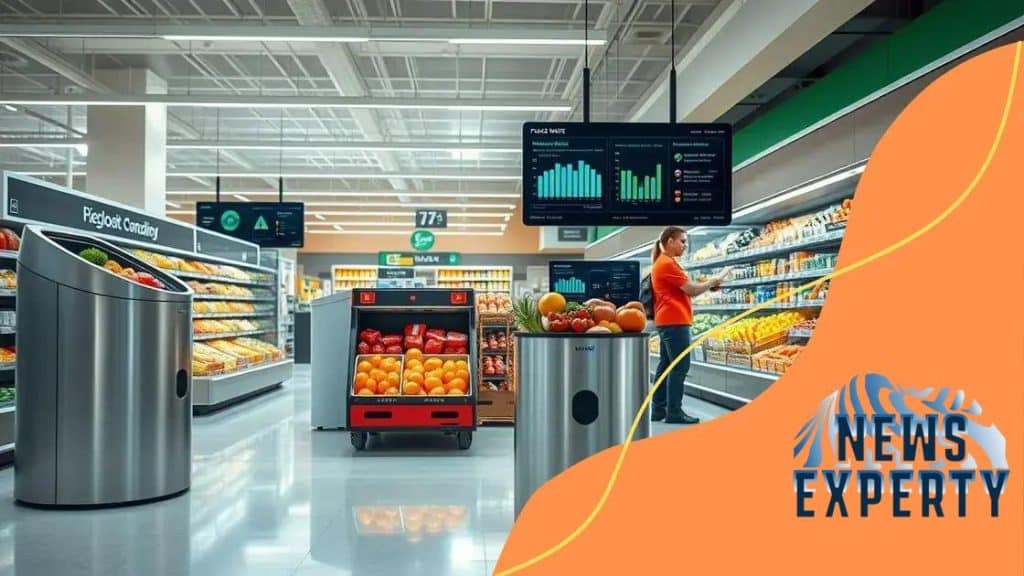Emerging technologies in the fight against food waste

Anúncios
Emerging technologies in the fight against food waste include AI for optimizing distribution, sustainable farming practices, and a circular economy approach that reuses resources to minimize waste.
Emerging technologies in the fight against food waste offer exciting solutions to one of the planet’s pressing challenges. Have you ever thought about how many resources go to waste every day? Let’s dive into these innovative approaches that are making a difference.
Anúncios
Understanding the impact of food waste
Understanding the impact of food waste is crucial for tackling this pressing issue. Every year, millions of tons of food are wasted globally, leading not only to economic losses but also significant environmental harm. It is vital to grasp the extent of this problem to develop effective solutions.
The Economic Consequences
The waste of food comes with a hefty price tag. In fact, it’s estimated that businesses lose billions due to unsold food and inefficient waste management. These financial losses can significantly affect the economy, especially for farmers and retailers.
- Lost profits for farmers.
- Increased costs in waste disposal.
- Impact on food prices.
Environmental Impact
Beyond economics, food waste carries a heavy environmental burden. When food is thrown away, it often ends up in landfills. This contributes to gas emissions, particularly methane, which is a potent greenhouse gas. Reducing food waste not only helps to protect the environment but can also contribute to a more sustainable future.
Anúncios
Moreover, it’s important to recognize that the resources used to produce wasted food—including water, land, and energy—are also squandered. By addressing food waste, we can conserve these valuable resources and work toward a healthier planet.
Social Implications
The impact of food waste isn’t just economic and environmental; it also touches on social issues. While many people struggle with hunger, vast amounts of edible food are discarded daily. This disconnect highlights the need for innovative solutions.
- Food redistribution programs.
- Community engagement initiatives.
- Education on food usage.
Each of these elements plays a part in understanding the broader effects of food waste. As we explore ways to combat this issue, it’s essential to consider all angles—from economic benefits to environmental preservation and social responsibility. The path forward requires collective effort and awareness.
Innovative apps for reducing waste
Innovative apps for reducing waste are changing the way we think about food consumption. With the rise of technology, many applications aim to help individuals and businesses manage food more efficiently. These tools are designed to minimize waste while maximizing the value of every meal.
Apps for Home Use
In households, there are several apps that assist users in tracking expiration dates and suggesting recipes based on available ingredients. This encourages users to utilize what they already have, avoiding unnecessary purchases that lead to waste.
- Apps that remind you of upcoming expiration dates.
- Recipe generators using leftover ingredients.
- Shopping lists that prioritize expiration dates.
Using these apps not only helps reduce waste but also saves money and sparks creativity in meal preparation.
Commercial Solutions
For businesses, there are innovative applications focused on inventory management and reporting food waste. These apps help restaurants and supermarkets track their stock levels and predict demand more accurately, drastically cutting down on waste.
Moreover, businesses can also partner with food-sharing platforms that connect them with local charities, allowing surplus food to be donated rather than discarded. This not only benefits the community but also helps organizations meet corporate sustainability goals.
- Inventory management systems for restaurants.
- Donation platforms for surplus food.
- Analytics tools for waste tracking.
As technology continues to evolve, the role of apps in reducing food waste becomes increasingly significant. They not only provide practical solutions but also engage the community in sustainability efforts. By leveraging these innovative tools, we can contribute to a healthier planet while making smarter choices.
Technological advancements in food preservation

Technological advancements in food preservation play a significant role in reducing waste and extending the shelf life of our food. As we seek to keep food fresher for longer, innovation in this field is essential.
Cooling and Freezing Techniques
Traditional methods such as freezing have evolved with modern technology. Today, ultra-rapid freezing allows food to retain its texture and nutrients. This technology freezes food quickly, minimizing ice crystal formation that can damage cells.
- Flash freezing technology for better texture.
- Smart refrigerators that monitor food freshness.
- Vacuum sealing to prevent freezer burn.
These innovations help maintain the quality of food while also reducing spoilage.
Preservation Through Packaging
Innovative packaging techniques also enhance food preservation. Edible coatings, for instance, can protect fruits and vegetables from spoilage. These coatings are made from natural compounds and help maintain freshness without chemicals.
Additionally, modified atmosphere packaging (MAP) changes the gas composition inside packaging to slow down decay. This method is widely used in ready-to-eat meals and snacks.
- Edible coatings for fruits and vegetables.
- MAP technology for extending shelf life.
- Biodegradable packaging alternatives.
Through these advancements, we can reduce our carbon footprint better and decrease food waste significantly.
Smart Technologies in Food Safety
Smart technologies are also making headway in food preservation. Intelligent sensors can monitor temperature and spoilage, alerting consumers and vendors before food goes bad. This proactive approach helps reduce waste at every level, from farms to consumers.
With these advancements, we can ensure food safety while minimizing waste. The combination of technology and smart practices paves the way for a more sustainable future.
Role of AI in food distribution
The role of AI in food distribution is becoming increasingly vital as the industry seeks to minimize waste and improve efficiency. By utilizing artificial intelligence, companies can streamline their operations and ensure a more sustainable supply chain.
Optimizing Supply Chains
AI technology allows businesses to analyze vast amounts of data in real-time. This analysis helps in predicting demand, which in turn reduces overproduction and waste.
- Forecasting demand based on historical data.
- Identifying trends in consumer behavior.
- Adjusting supply levels dynamically.
Using AI for these purposes leads to a more responsive supply chain, ensuring that food reaches consumers efficiently without unnecessary surplus.
Improving Logistics
Logistical challenges can contribute significantly to food waste. AI algorithms help optimize delivery routes, ensuring that products spend less time in transit and are delivered more quickly. With advanced route planning, companies can save fuel and reduce emissions as well.
Smart logistics are vital for keeping food fresh. Real-time tracking and monitoring systems ensure that temperature-sensitive items, like fresh produce and dairy, remain in optimal conditions throughout their journey.
- Smart routing for faster deliveries.
- Temperature monitoring during transportation.
- Predictive maintenance for delivery vehicles.
By integrating these systems, businesses can significantly reduce waste caused by spoilage during transportation.
Enhancing Consumer Engagement
AI also plays a role in engaging consumers directly through personalized marketing and feedback systems. By understanding consumer preferences, companies can adjust their offerings to match what customers want, minimizing excess production.
Additionally, feedback loops allow businesses to gather data on consumer satisfaction and waste patterns. This information can inform future decisions, helping to close the loop on waste in food distribution.
The integration of AI in food distribution represents a significant step towards a more sustainable and efficient food system. As technology continues to evolve, its impact on reducing waste will only grow stronger.
Circular economy and sustainable practices
The circular economy and sustainable practices are essential in the fight against food waste. By focusing on reusing and recycling resources, we can create a system where waste is minimized and valuable materials are conserved. This approach not only helps the environment but also boosts the economy.
Understanding Circular Economy
A circular economy is a system that aims to keep products, equipment, and infrastructure in use longer. This involves designing products for longer life spans, repairability, and recyclability. In the context of food, this means utilizing every part of the product and reducing the demand for new resources.
- Reducing waste by repurposing food scraps.
- Designing packaging that can be reused or recycled.
- Implementing closed-loop systems in food production.
By understanding these principles, businesses can make more sustainable choices in how they operate.
Sustainable Practices in Food Production
Sustainable practices play a key role in reducing food waste. This includes methods such as regenerative farming, which improves soil health and biodiversity. Additionally, local sourcing of ingredients minimizes transportation emissions and helps support local economies.
These practices not only benefit the environment but also enhance the flavor and quality of food products. When consumers choose sustainable options, they contribute to a healthier planet.
Consumer Engagement and Education
Engaging consumers is vital in promoting a circular economy. This can be achieved through educational campaigns that inform people about the benefits of sustainable practices. Teaching individuals how to compost and make the most of their groceries can significantly reduce waste.
Community programs that encourage sharing surplus produce also help in fostering a culture of sustainability. By getting communities involved, we can create impact on a larger scale.
The integration of concepts from the circular economy into everyday practices is a powerful tool for fighting food waste. As consumers and businesses adopt these sustainable approaches, the potential for positive change in the food system grows immensely.
FAQ – Frequently Asked Questions about Emerging Technologies in the Fight Against Food Waste
How can AI help reduce food waste?
AI optimizes supply chains and predicts demand, which minimizes overproduction and waste in the food system.
What is a circular economy?
A circular economy focuses on reusing resources and minimizing waste through sustainable practices in production and consumption.
How can consumers get involved in reducing food waste?
Consumers can participate by learning about food preservation, composting, and sharing surplus food within their communities.
What role does technology play in food distribution?
Technology enhances logistics, improves efficiency in delivery routes, and ensures better tracking of food freshness to reduce spoilage.





